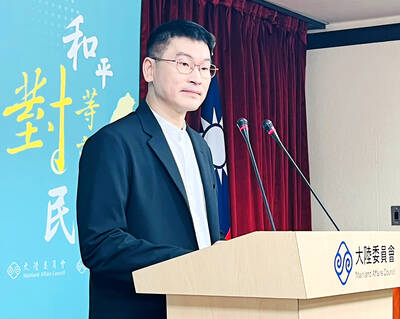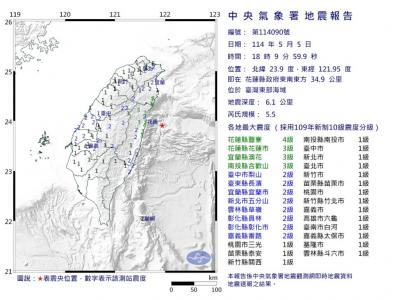Scientists have concluded, after reconstructing the event, that more than 30 million tonnes of mud rushed down from a nearby mountain, burying half of Siaolin Village (小林) in Jiasian Township (甲仙), Kaohsiung County, in just 110 seconds, while a second mudslide that came a little more than 30 minutes later buried the rest of the village during the height of Typhoon Morakot in August last year.
After more than half a year of field research and computer simulations, a team of geologists from several universities commissioned by the National Science Council released the results of their research yesterday.
Most of the village — along with more than 500 people — was buried under massive mudslides triggered by heavy rainfall brought on by the typhoon early on the morning of Aug. 9 last year.

PHOTO: LIAO CHEN-HUEI, TAIPEI TIMES
“More than 30 million tonnes of mud rushed down from nearby Mount Siandu [獻肚山] at a speed of 180kph when the mountain collapsed,” Chen Chien-chih (陳建志), a professor at National Central University’s Graduate Institute of Geophysics, told a press conference yesterday. “The massive mudslide was divided into two ... only 30 seconds after it began — the larger mudslide continued on until it hit the Cishan River [旗山溪] valley, wiping out the northern part of Siaolin. This explains why some survivors said they heard two large bangs that morning.”
He said it was only 110 seconds from the beginning of the mudslide until the northern part of the village was wiped out.
The smaller mudslide went down the valley of a smaller, unnamed creek and formed a barrier lake, Chen said.
“As the mud, sand and stones built up, the barrier lake eventually collapsed 30 to 50 minutes later, burying the southern part of the village,” he said. “Most of the survivors came from the south of the village — they made it out in time, before the second mudslide buried the southern part of the village.”
National Taiwan University geosciences professor Hongey Chen (陳宏宇) said that long-term unstable geological composition was one of the causes of the tragedy.
“Field research found the geological composition of Mount Siandu to be quite unstable as it’s located on the border between shale and sandstone composition, and many geological layers there are actually leftover debris from ancient mountain collapses that occurred thousands of years ago,” Hongey Chen said. “If nothing happens, nothing happens — but if exceptionally heavy rainfall occurs, unstable layers can be washed down at any time.”
He said that as many as 92 other communities in Nantou, Chiayi, Tainan, Kaohsiung, Pingtung and Taitung counties are also under threat from unstable geological compositions.
Although the team attributed the mudslides to unstable geological composition and heavy rainfall, they could not rule out the possibility that the large amount of explosives used to construct a water diversion tunnel in the area had contributed to the collapse.
“Our research was totally based on the geological side of the issue, we didn’t really look into the effect of the explosives,” Hongey Chen said. “The Public Construction Commission released a report on it earlier [which concluded that it had nothing to do with the collapse] and we respect that.”

An essay competition jointly organized by a local writing society and a publisher affiliated with the Chinese Communist Party (CCP) might have contravened the Act Governing Relations Between the People of the Taiwan Area and the Mainland Area (臺灣地區與大陸地區人民關係條例), the Mainland Affairs Council (MAC) said on Thursday. “In this case, the partner organization is clearly an agency under the CCP’s Fujian Provincial Committee,” MAC Deputy Minister and spokesperson Liang Wen-chieh (梁文傑) said at a news briefing in Taipei. “It also involves bringing Taiwanese students to China with all-expenses-paid arrangements to attend award ceremonies and camps,” Liang said. Those two “characteristics” are typically sufficient

A magnitude 5.9 earthquake that struck about 33km off the coast of Hualien City was the "main shock" in a series of quakes in the area, with aftershocks expected over the next three days, the Central Weather Administration (CWA) said yesterday. Prior to the magnitude 5.9 quake shaking most of Taiwan at 6:53pm yesterday, six other earthquakes stronger than a magnitude of 4, starting with a magnitude 5.5 quake at 6:09pm, occurred in the area. CWA Seismological Center Director Wu Chien-fu (吳健富) confirmed that the quakes were all part of the same series and that the magnitude 5.5 temblor was

The brilliant blue waters, thick foliage and bucolic atmosphere on this seemingly idyllic archipelago deep in the Pacific Ocean belie the key role it now plays in a titanic geopolitical struggle. Palau is again on the front line as China, and the US and its allies prepare their forces in an intensifying contest for control over the Asia-Pacific region. The democratic nation of just 17,000 people hosts US-controlled airstrips and soon-to-be-completed radar installations that the US military describes as “critical” to monitoring vast swathes of water and airspace. It is also a key piece of the second island chain, a string of

The Central Weather Administration has issued a heat alert for southeastern Taiwan, warning of temperatures as high as 36°C today, while alerting some coastal areas of strong winds later in the day. Kaohsiung’s Neimen District (內門) and Pingtung County’s Neipu Township (內埔) are under an orange heat alert, which warns of temperatures as high as 36°C for three consecutive days, the CWA said, citing southwest winds. The heat would also extend to Tainan’s Nansi (楠西) and Yujing (玉井) districts, as well as Pingtung’s Gaoshu (高樹), Yanpu (鹽埔) and Majia (瑪家) townships, it said, forecasting highs of up to 36°C in those areas